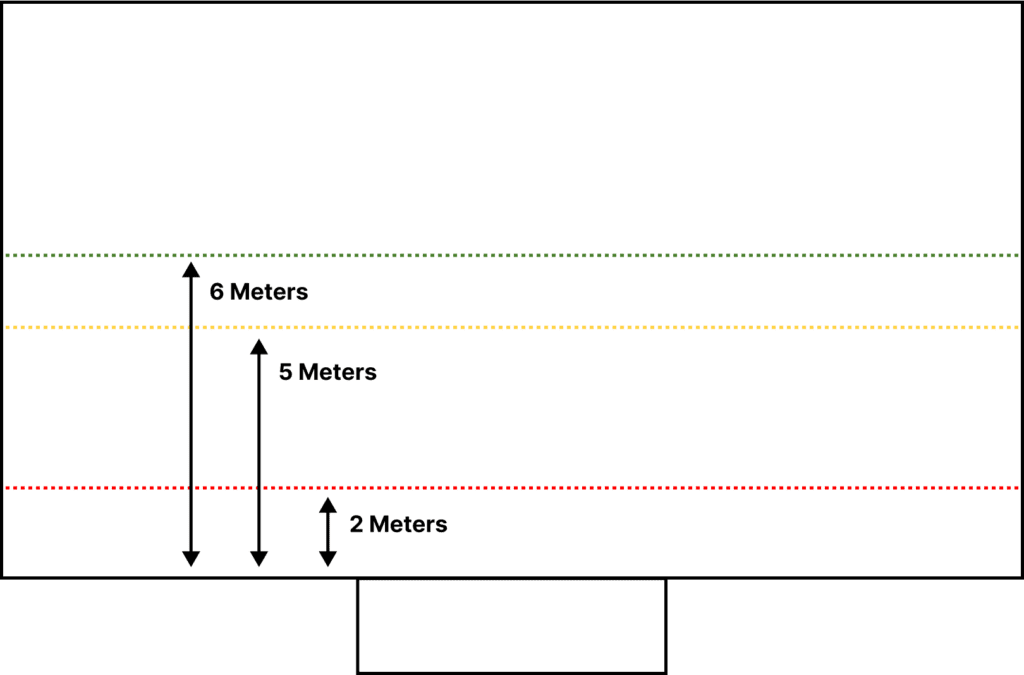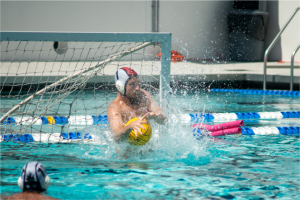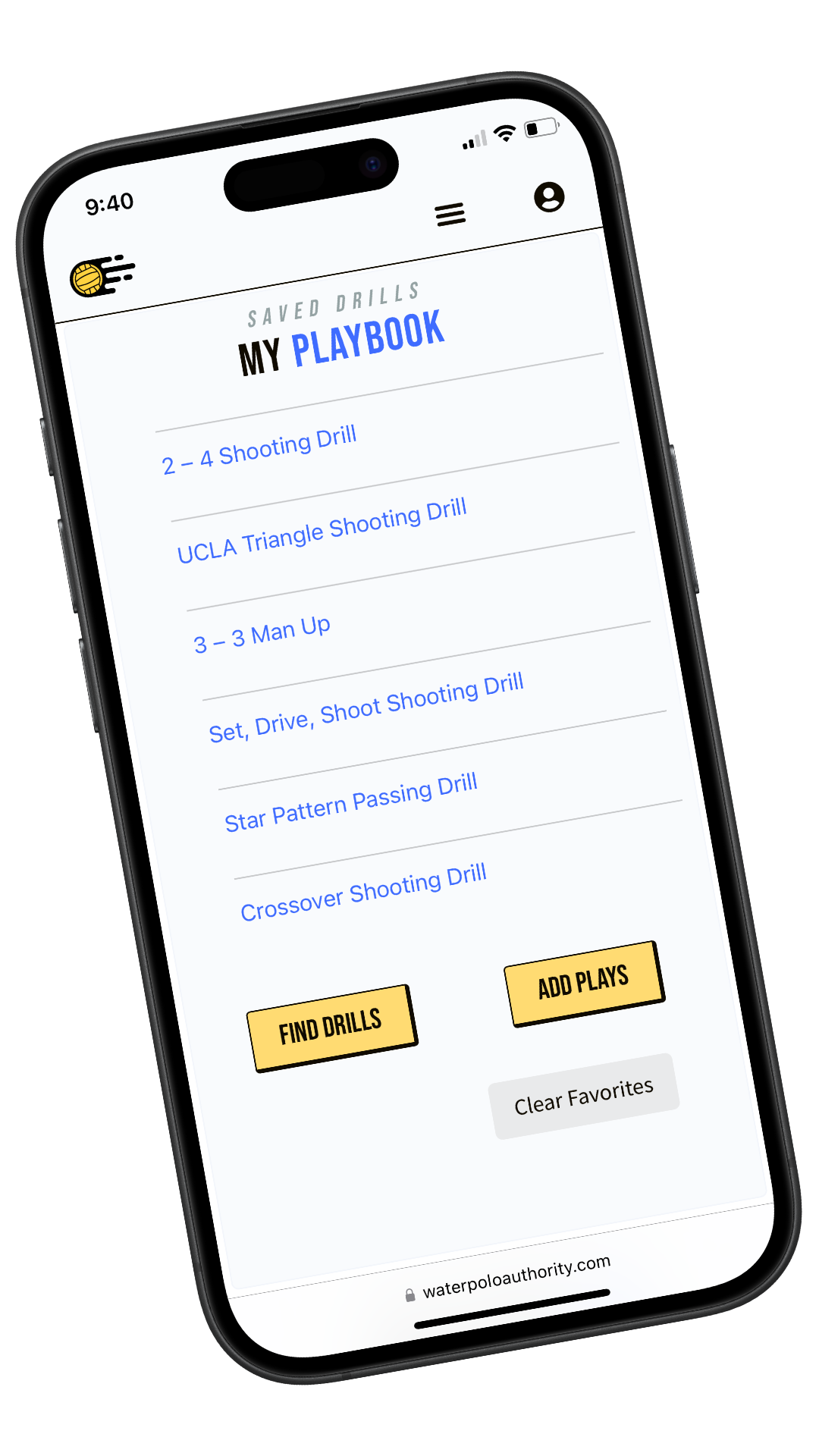Water polo athletes, coaches, and fans use many unique water polo terms to describe aspects of the game. During a game, you might hear a player shouting strange terms like, “man up!”, and wonder what exactly that means in the context of the game. Here’s our full glossary covering some of the most widely used water polo terms that you should know to better understand and enjoy the game.
2 meter: Refers to the area two meters in front of the goal where offensive players position themselves to create scoring opportunities. An offensive player cannot be inside the 2-meter line unless the ball was there first. The term ‘2 meter’ also refers to the corner throw that takes place after a goalie has made a block, but the ball left the area of play.
5 meter: A 5-meter in water polo refers to both the 5-meter line and a penalty shot given to the attacking team for a major defensive foul within this area. It’s awarded when the fouled player is likely to score but is obstructed. The player then takes an unimpeded shot from the 5-meter line against the goalkeeper, with a high chance of scoring.
6 meter line: A player that draws an ordinary foul outside of the 6-meter of line is allowed to shoot directly at the goal without faking. If a player is inside this 6-meter line when fouled then they are not allowed to shoot and may only pass the ball.

Bar out: Occurs when a shot hits the goalpost or the crossbar and does not go it, either rebounding back in play or ricocheting out of bounds.
Brutality: A severe and deliberate foul involving excessive physical force, resulting in a player’s ejection from the game.
Counter/counterattack: A term used to describe the transition from defense to offense when a player has a leading stroke ahead of the other team’s players.
Cross cage: Shooting to the opposite corner of the goal from where a player is. If the player is lined up along the left post of the goal then this would mean shooting to the right side of the goal.
Driver: A player who primarily is in constant movement on offense in an effort to create an advantage for their team. Learn more about the different positions in water polo.
Drop: A drop is a type of defensive strategy where a defensive player helps cover another offensive player by dropping back into zone coverage.
Dry pass: To make a pass without letting the ball touch the water.
Dump the ball: A tactical decision when the shot clock is winding down to throw the ball away instead of taking a low probability shot on goal. The dumped ball is often thrown into the corner of the pool in order to slow the other team down from starting their offensive possession.
Eggbeater: A technique used by water polo players to maintain an upright position in the water.
Ejection/kick out: A penalty imposed on a player for committing a major foul. The ejected player must leave the playing area for 20 seconds, leaving their team temporarily short-handed, or man-down.
Field block: When a defensive player successfully blocks an opponent’s shot attempt.
Free throw (make the ball live): Players are awarded an ordinary or minor foul when a defensive player has impeded their play while in possession of the ball. This results in the offensive player being awarded a free throw where they can either pass or shoot, depending on their location in the pool.
Front: A defensive tactic where the hole D guards in front of the hole set as to try and prevent passes from entering.
Hole D: The center defensive position, short for “hole defense”. Their goal is to deny or limit the hole set’s receiving and scoring options.
Hole Set: The offensive player positioned in the center forward position. Their goal is to receive passes and create scoring opportunities.
Impeding: Refers to an illegal action where a player obstructs the movement or progress of an opponent without actively playing the ball. Impeding results in a foul and possible exclusion.
Inside water: The advantageous position where an offensive player establishes themselves between the defender and the goal, allowing for a higher chance of receiving a pass and creating a scoring opportunity.
Lob shot: A shooting technique where the offensive player intentionally tosses the ball higher into the air, aiming to clear the goalkeeper’s reach and score by dropping the ball into the goal from above.
Man Down: The situation where a team has one player ejected, temporarily reducing their numbers and leaving them at a disadvantage.
Man Up (6 on 5): The advantageous situation where a team has one more player in the pool due to an exclusion penalty against the opposing team. Also known as a power play.
Near side: This is a reference to shooting to the same side of the goal that a player is lined up on, the opposite of cross cage.
Offensive: A foul committed by a player on the offense that results in the loss of possession of the ball.
Ordinary foul: A minor foul committed during gameplay, such as impeding an opponent or minor physical contact. An ordinary foul results in the player being awarded a free throw.
Post up: A movement on offense where a player ‘posts up’ a player on defense by positioning themselves in front of the goal and acting as a hole set.
Press: A defensive strategy where players actively guard their opponents, applying pressure to disrupt passing lanes and limit their offensive options.
Power Play: A man up situation where one team has a player excluded for 20 seconds, giving the other team an advantage. Typically referred to as ‘man up’ or ‘6 on 5’.
Shot clock (yellow/red): The shot clock sets a time limit for the offensive team to take a shot on goal. “Yellow” is called out when the shot clock is :10 seconds from expiring, while “red” is often called out when there are only :5 seconds left.
Skip shot: A shooting technique where the offensive player intentionally bounces the ball on the water’s surface.
Strong side: Typically refers to the left side of the pool while on offense where right-handed players have a higher probability of scoring due to having a better angle for taking shots.
Swim off: The initial race for possession that occurs at the beginning of each period.
T-shot: A type of wet shot where a player shoots the ball while swimming by grabbing the ball from underneath with one hand and forcefully pushing the ball with the other hand.
Utility: A versatile player who can play multiple positions and fulfill various roles within the team.
Wet pass: A pass thrown towards another player with the intention of the ball landing on the surface of the water.
Wet shot: A shot taken while swimming and dribbling the ball toward the goal.
Weak side: The side of the pool opposite to strong side, where right-handed players have a worse shooting angle.



